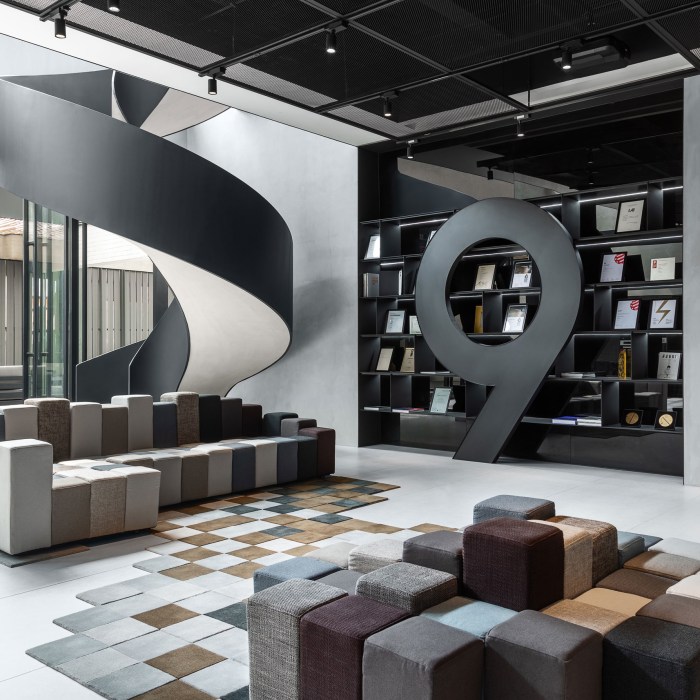Exploring the World of Interior Architecture

Step into the realm of interior architecture where creativity meets functionality, and spaces come alive with innovative designs. This captivating journey will uncover the secrets behind creating stunning interiors that blend artistry with practicality.
Overview of Interior Architecture
Interior architecture is the art and science of designing and creating interior spaces that enhance the functionality, aesthetics, and overall quality of a building. It focuses on the structural elements within a space, such as walls, floors, and ceilings, as well as the flow and interaction of people within the space.Interior architecture differs from interior design in that it involves more technical aspects of building and construction, such as understanding building codes, structural integrity, and spatial planning.
Interior designers, on the other hand, primarily focus on the decorative elements of a space, such as furniture, color schemes, and accessories.Key elements involved in interior architecture include spatial planning, lighting design, material selection, and furniture layout. These elements work together to create a cohesive and functional interior space that meets the needs and desires of the occupants.Some examples of famous interior architecture projects include the Guggenheim Museum in Bilbao, Spain, designed by Frank Gehry, which features innovative use of curved and angled walls to create a dynamic and visually striking interior space.
Another example is the Sydney Opera House in Australia, designed by Jørn Utzon, known for its iconic sail-like roof structure and innovative use of concrete and glass in the interior spaces.
Principles of Interior Architecture
Interior architecture is guided by several fundamental principles that shape the design and functionality of indoor spaces. These principles are essential in creating harmonious and aesthetically pleasing environments that cater to the needs and preferences of inhabitants.
Spatial Planning in Interior Architecture
Spatial planning is a crucial aspect of interior architecture as it involves organizing and arranging spaces to optimize functionality and flow. Designers consider factors such as circulation, zoning, and ergonomics to ensure that the layout of a space is efficient and user-friendly.
- Effective spatial planning helps in creating seamless transitions between different areas within a space, enhancing the overall user experience.
- By carefully planning the placement of furniture, fixtures, and other elements, interior architects can maximize the use of space and create visually appealing interiors.
- Consideration of spatial planning also plays a significant role in accommodating specific activities or functions within a space, ensuring that it meets the practical needs of its users.
Importance of Lighting in Interior Architecture
Lighting is a key element in interior architecture that can greatly influence the mood, ambiance, and functionality of a space. Proper lighting design can highlight architectural features, create focal points, and enhance the overall aesthetics of a room.
- Well-planned lighting schemes help in defining different zones within a space, providing adequate illumination for various activities while also creating a sense of balance and harmony.
- Lighting design also impacts the perception of space, making rooms appear larger or cozier based on the intensity and color temperature of the light sources used.
- By incorporating natural light and artificial lighting solutions, interior architects can create dynamic and versatile environments that adapt to different needs and preferences throughout the day.
Significance of Materials and Textures in Interior Architecture
Materials and textures play a vital role in interior architecture by adding depth, richness, and character to a space. The choice of materials can evoke specific moods, convey a sense of luxury, or establish a particular style within a design.
- The selection of materials such as wood, metal, glass, and textiles can influence the tactile and visual experience of a space, creating a sensory connection with its users.
- Textures, whether smooth, rough, glossy, or matte, contribute to the overall aesthetic appeal of a design, adding interest and contrast to surfaces and finishes.
- Combining a variety of materials and textures in a thoughtful manner allows interior architects to create unique and personalized spaces that reflect the individuality and lifestyle of the occupants.
Integration of Technology in Interior Architecture
Technology plays a significant role in shaping the modern landscape of interior architecture. From virtual reality to smart home systems, innovative technological applications have revolutionized the way interior spaces are designed and experienced.
Virtual Reality and 3D Modeling
Virtual reality (VR) and 3D modeling have become essential tools in the design process of interior architecture. Designers can create realistic virtual environments, allowing clients to visualize and experience the space before it is even built. This technology enables more accurate planning, efficient communication, and better decision-making throughout the design process
Smart Home Systems
Smart home systems have transformed the way interior architecture interacts with technology. From automated lighting and climate control to security systems and entertainment centers, smart technology seamlessly integrates into interior spaces, enhancing convenience, comfort, and energy efficiency. These systems not only improve the functionality of a space but also contribute to the overall design aesthetic.
Innovative Technological Applications
In addition to VR, 3D modeling, and smart home systems, there are numerous other innovative technological applications in interior architecture. For example, augmented reality (AR) can overlay digital information onto physical spaces, providing interactive and immersive experiences. Advanced materials and construction techniques, such as 3D printing and robotic fabrication, are also pushing the boundaries of what is possible in interior design.
These technologies open up a world of possibilities for creating unique, sustainable, and responsive interior environments.
Sustainable Practices in Interior Architecture
As the world becomes more environmentally conscious, the importance of sustainability in interior architecture cannot be overstated. Designing spaces that are not only visually appealing but also eco-friendly is crucial for the well-being of our planet.
Eco-Friendly Materials in Sustainable Interior Design
Using eco-friendly materials is a key aspect of sustainable interior design. Materials such as reclaimed wood, bamboo, cork, and recycled glass not only reduce the impact on the environment but also add a unique aesthetic to the space.
Energy-Efficient Solutions in Interior Architecture
Implementing energy-efficient solutions in interior architecture is essential for reducing the carbon footprint of buildings. This can include using LED lighting, smart thermostats, and energy-efficient appliances to minimize energy consumption.
Incorporating Biophilic Design Principles
Biophilic design principles focus on connecting interior spaces with nature to improve the well-being of occupants. Incorporating elements such as natural light, indoor plants, and natural materials can create a healthier and more sustainable environment.
Summary

As we conclude our exploration of interior architecture, we are left with a deep appreciation for the intricate balance between aesthetics and functionality in shaping living spaces. The fusion of creativity and technical expertise showcased in this discussion truly highlights the transformative power of interior architecture.
User Queries
What is the significance of interior architecture?
Interior architecture focuses on the design and optimization of interior spaces to enhance both aesthetics and functionality.
How does interior architecture differ from interior design?
While interior design focuses on the aesthetics and decoration of spaces, interior architecture emphasizes the structural layout and spatial functionality.
What are the key elements involved in interior architecture?
The key elements include spatial planning, lighting, materials, textures, and the integration of technology.
How does technology influence modern interior architecture?
Technology plays a significant role in modern interior architecture through tools like virtual reality, 3D modeling, and smart home systems.
Why is sustainability important in interior architecture?
Sustainability is crucial in interior architecture to promote eco-friendly practices, energy efficiency, and the use of environmentally conscious materials.




